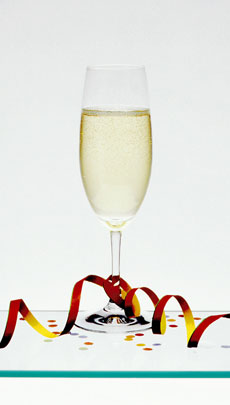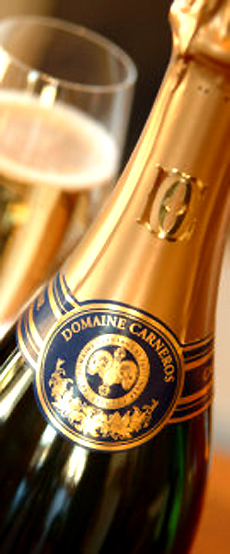 You don’t need Champagne to celebrate. All sparkling wines are festive! Photo courtesy Champagne Bureau U.S. You don’t need Champagne to celebrate. All sparkling wines are festive! Photo courtesy Champagne Bureau U.S.
|
R. VERONIQUE FITZGERALD is wine consultant and writer in New York City.
|
December 2007
Updated December 2008
|
 |
Product Reviews / Main Nibbles / Wine
Champagne & Sparkling Wine
Page 4: Great Sparkling Wine
This is Page 4 of a five-page article. Click on the black links below to visit other pages.
Great Sparkling Wine
Some wineries in California, upstate New York and other places in the U.S. continue to use the word Champagne on their labels, instead of calling their products sparkling wine, despite the fact that Champagne has Protected Designation of Origin (PDO) status from the European Union. While the U.S. recognizes this, a statute* allows longtime domestic producers to continue to use the term under specific circumstances. However, it is the public that is ultimately misled, when trying to reconcile the flavors and aromas of true Champagne with so-called products from other companies. While the only grapes permitted into PDO Champagne are Chardonnay, Pinot Noir and Pinot Meunier, American “Champagne” (and that made in other countries besides France) can be made from any grape the producer chooses. They do not have to be made by the traditional method.
*Section 5388(c) of Title 26 of the United States Code.
Yet, there are some fantastic American bubblies made in the traditional method, often from the traditional grape varieties, some by Champagne houses who have set up wineries abroad. These wines will not have the word Champagne on their labels, out of  respect for the PDO, and can be relatively less expensive than the “real thing” while offering a quality experience. Here are a few of them. respect for the PDO, and can be relatively less expensive than the “real thing” while offering a quality experience. Here are a few of them.
Domaine Carneros by Taittinger
Brut 2003
$22.00 to $28.00
Made in Napa, California by the great French Champagne house of Taittinger, and aged in bottle three years before release, Domaine Carneros Brut is consistently complex and rich with great mineral and earthy characters layered with berry fruit. The 2003 vintage is no exception. Vintages as late as 2004 are available, and a Tarzana, California store still has the 1997 in stock. If you’re headed to Napa, a visit to the Domaine Carneros château in Carneros is an event. Sit on the terrace overlooking manicured landscape in the front and vineyards all around and live the good life vicariously for a few hours. You also can taste their line of Pinot Noirs, some of which are not available outside of the winery.
Roederer Estate Anderson Valley NV
$16.00 to $20.00
The great French Champagne house of Louis Roederer (makers of the iconic tête de cuvée Cristal) set down roots in California decades ago. This non-vintage brut made from grapes grown in Mendocino County shows the forward fruit of a California wine, but all the elegance and balance of a good Champagne.
Roederer Estate Vintage Brut, L’Ermitage
$40.00 to $60.00
The vintage brut, L’Ermitage, is definitely a step up in complexity and elegance. Vintages ranging from 1998 to 2000 are available for around $40.00. Cellar 91 in Portland, Oregon has the 1996 in Magnum for $89.00.
Gruet New Mexico NV
$13.50
The French firm of Gruet et Fils had been in the Champagne business for 31 years when Gilbert Gruet happened upon a golden opportunity in Engle, New Mexico. Near the town of Truth or Consequence (we don’t make this up), there lay acres of inexpensive land that had already been tried and proven for grapevines by other winemakers. In 1984, Gruet planted an experimental vineyard and subsequently relocated two of his children to New Mexico to supervise their wine-making tradition. The result is a very reasonably-priced, traditional-method bubbly, medium bodied and silky, with citrus fruit and a toasty finish. Half bottles are available for around $7.00. The wine is widely available in the northeast and California (and, of course, New Mexico).
Cava
Spain
Traditional method wines outside Champagne are epitomized by Cava, the Catalan bubbly sold at a fraction of the price of Champagne. Freixenet, recognized by its iconic black bottle, is the number one brand of Cava in the U.S. Other names worth finding are Segura Viudas, Raventos and Cristalino. These usually don’t have as much character and body as Champagne does, but at $10.00 or so a bottle, are the best choice for mimosas and Bellinis. See the recipe below.
Bellini Recipe
Try this Bellini recipe from The Ultimate A-To-Z Bar Guide by Herbst & Herbst.
Ingredients
- 1 medium ripe peach, peeled and puréed or 3 ounces peach nectar
- 4 to 6 ounces ice-cold dry sparkling wine
Preparation
- Pour the peach purée into a chilled Champagne flute.
- Slowly pour the sparkling wine over the peach purée. Pouring the bubbly over the back of a teaspoon, so it floats on top of the peach purée creates, a beautiful layered effect. Stir once, gently, before drinking—vigorous stirring breaks the wine bubbles.
Continue To Page 5: Other Sparkling Wines
Go To The Article Index Above
Lifestyle Direct, Inc. All rights reserved. Images are the copyright of their respective owners.

|





 respect for the PDO, and can be relatively less expensive than the “real thing” while offering a quality experience. Here are a few of them.
respect for the PDO, and can be relatively less expensive than the “real thing” while offering a quality experience. Here are a few of them.